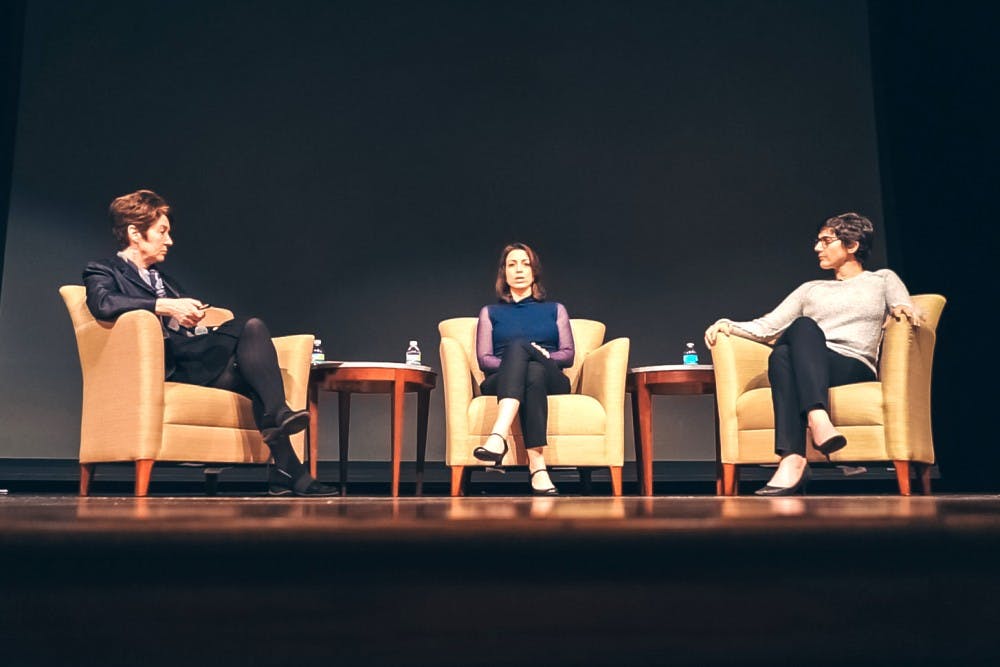Laura Ricciardi and Moira Demos can pinpoint the moment that inspired their Netflix docuseries "Making a Murderer."
It was 2005. They were film students at Columbia University, on a train and a New York Times headline caught their attention: "Freed by DNA, Now Charged in New Crime." Two photos accompanied the headline, both depicting its subject Steven Avery. One featured a freshly exonerated Avery in 2003, after he'd served 18 years for a crime he hadn't committed. The second presented Avery two years later, now accused of murder.
"We thought Steven Avery really was this ideal window into the system," Ricciardi said to a group of students gathered in Hall Auditorium on Monday.
She and Demos intended to document Avery's plight as well as his then-17-year-old nephew Brendan Dassey's, also convicted of murdering 25-year-old photographer Teresa Halbach. They figured they'd make a feature.
But, after the filmmakers delved deeper into Avery and Dassey's ordeal, they realized that two hours was not nearly enough time for the story they wanted to tell.
Ten years later, "Making a Murderer" premiered on Netflix in December 2015 and seized the nation's collective attention -- and sympathy. Memes revering Avery's defense lawyers flooded social media, fans dreamed up casts for a potential film adaptation and vilified prosecutor Ken Kratz was obliterated on Yelp.
A petition to free Avery earned over 100,000 votes and a response from the White House, though, as they wrote, his particular case falls under state jurisdiction.
Ricciardi and Demos told a crowd of students gathered in Hall Auditorium Monday that they couldn't have foreseen the success of the show but hope that it continues to fuel the nation's discussion on America's controversial criminal justice system.
As Demos pointed out, "There's no such thing as a dialogue if everyone's saying the same thing."
To film the series, Ricciardi and Demos moved to Wisconsin and were present for the duration of Avery and Dassey's trials. They believe that this helped them in gaining the docuseries' subjects' trust, though some -- most notably the Halbach family and Kratz -- refused to speak to them.
"Our goal was to sort of give viewers the experience that we had," Demos said. "What it would be like to be on the ground and know these people."
"It wasn't as though we were swooping in for the big event, then leaving and coming back," Ricciardi said. "We were in it for the long haul. We wanted to be thorough."
Enjoy what you're reading?
Signup for our newsletter
"Making a Murderer," which has garnered criticism for its apparent bias towards Avery and his family, follows him from his euphoric initial exoneration to the end of his murder trial in 2007. It raises disturbing questions about the Manitowoc County sheriff's department, who had already imprisoned Avery in 1985 for a crime he didn't commit; due to Avery's current lawsuit against Manitowoc, adjoining Calumet County officially investigated the Halbach murder.
However, it was Manitowoc sheriff's deputies who uncovered arguably the most damning evidence in Avery's case (Halbach's car key, found in Avery's bedroom). This lead his defense lawyers (and impassioned viewers) to believe that Avery was, once again, framed.
"These are public officials," Ricciardi said, referencing the officers and lawyers who pushed for Avery and Dassey's imprisonment. "They work for us. They have to abide by the law and if they don't, then we're all fair game and our rights don't matter."
Avery and Dassey remain locked up, but experienced attorney Kathleen Zellner has taken on Avery's case. Dassey, was set for release last fall from a U.S. District Judge's order, but blocked by a Wisconsin judge in November. Both are currently awaiting results of appeals for new trials.
Season two will likely cover these new developments, plus whatever material Ken Kratz chooses to write about in his tell-all book, set for release Feb. 21. The universal question in the audience on Monday was, when will it premiere?
"As soon as we can get it finished," Demos said.




